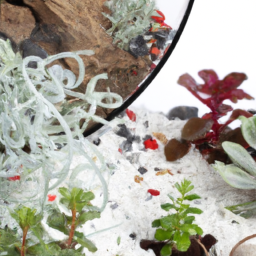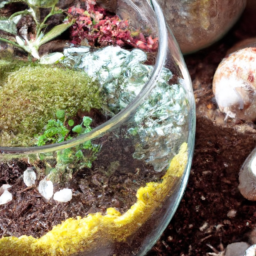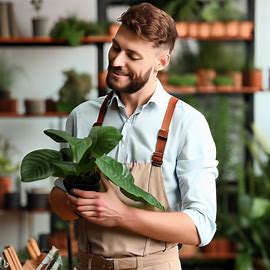
Are you looking for a unique way to bring a touch of nature into your modern home? Look no further than the terrarium craze! These tiny ecosystems have taken the interior design world by storm, offering a perfect blend of greenery and style for any living space. Whether you have a green thumb or struggle to keep even the simplest plants alive, terrariums are a low-maintenance solution that can add a breath of fresh air to your home decor. In this blog post, we’ll explore the terrarium craze and how you can create your own miniature world within the confines of a glass container. So, let’s dive into the fascinating world of terrariums and discover why they are the perfect addition to modern homes.
The Benefits of Terrariums for Modern Homes
Terrariums have become increasingly popular in modern homes due to their unique ability to bring nature indoors. These miniature ecosystems offer numerous benefits, both aesthetically and environmentally. In this article, we will explore the various advantages of incorporating terrariums into your home decor.
1. Enhances Indoor Air Quality
One of the significant benefits of terrariums is their ability to improve indoor air quality. The plants within the terrarium act as natural air purifiers, removing toxins and releasing oxygen. With the increasing pollution levels in urban areas, having a terrarium can help create a healthier living environment. The plants absorb harmful chemicals and release clean, fresh air, making your home a more pleasant place to live.
Additionally, terrariums can help regulate humidity levels indoors. The enclosed environment of a terrarium creates a mini greenhouse effect, trapping moisture and increasing humidity. This can be particularly beneficial during dry seasons or in regions with low humidity. The increased moisture levels can alleviate respiratory problems and reduce the occurrence of dry skin and allergies.
Furthermore, terrariums can act as natural humidifiers, reducing the need for artificial humidifiers that consume electricity and require regular maintenance.
2. Low Maintenance and Space-Saving
Terrariums are ideal for those with a busy lifestyle or limited space. These self-contained ecosystems require minimal maintenance compared to traditional potted plants. Once set up, terrariums can thrive with minimal intervention. The closed container creates a self-sustaining environment where the plants recycle moisture and nutrients, reducing the need for frequent watering and fertilization.
Moreover, terrariums are space-saving solutions for modern homes. With urban living becoming more compact, terrariums provide an opportunity to bring nature indoors without taking up much space. Whether you live in a small apartment or a large house, a terrarium can fit seamlessly into any corner, shelf, or tabletop, adding a touch of greenery to your living space.
Additionally, terrariums can be designed in various shapes and sizes, allowing you to customize them according to your available space and personal preferences. From hanging terrariums to desktop terrariums, there are options to suit every home.
3. Stress Reduction and Mental Well-being
Research has shown that exposure to nature can have a positive impact on mental well-being. Terrariums offer a way to bring nature into your home, providing a sense of calm and relaxation. The act of tending to a terrarium, such as pruning and watering, can be therapeutic and help reduce stress levels.
Furthermore, the presence of greenery indoors has been linked to improved focus, productivity, and creativity. Having a terrarium in your workspace or study area can enhance your cognitive abilities and create a more conducive environment for work or study.
In addition to their mental health benefits, terrariums can also serve as decorative elements, adding visual appeal to your home. The lush green foliage and unique shapes of the plants create a visually captivating display, making your living space more inviting and aesthetically pleasing.
In conclusion, terrariums offer numerous benefits for modern homes. From improving indoor air quality to providing low-maintenance greenery and promoting mental well-being, these tiny ecosystems are a perfect addition to any living space. Consider incorporating a terrarium into your home decor and experience the beauty and advantages they bring.

How to Create and Care for a Terrarium in Your Home
Welcome to the wonderful world of terrariums! These miniature ecosystems are not only visually appealing but also a great way to bring a touch of nature into your modern home. Whether you have a green thumb or are just starting out, creating and caring for a terrarium is an enjoyable and rewarding experience. In this guide, we will take you through the step-by-step process of creating and maintaining a terrarium that will thrive in your home.
Choosing the Right Container
The first step in creating a terrarium is selecting the right container. The container you choose will determine the overall aesthetic of your terrarium, so it’s important to choose one that suits your style and preferences. Popular options include glass jars, fish tanks, and even repurposed glassware like mason jars or coffee pots. Ensure that the container has a lid or can be covered to create a humid environment for your terrarium.
Once you have chosen your container, it’s time to gather the necessary materials. You will need:
- Container
- Gravel or pebbles
- Activated charcoal
- Potting soil
- Plants
- Moss or decorative elements (optional)
Building the Layers
Now that you have your container and materials ready, it’s time to build the layers of your terrarium. This step is crucial as it creates the foundation for the ecosystem to thrive. Start by adding a layer of gravel or pebbles to the bottom of the container. This layer will act as a drainage system, preventing water from pooling at the bottom and causing root rot.
On top of the gravel layer, add a thin layer of activated charcoal. The charcoal will help filter the air and water within the terrarium, keeping it fresh and preventing any unpleasant odors. Next, add a layer of potting soil, ensuring it is deep enough for the roots of your chosen plants. You can create different levels and slopes within the soil to add visual interest to your terrarium.
Choosing the Right Plants
Now comes the fun part – choosing the plants for your terrarium! When selecting plants, it’s important to consider their size, growth habits, and light requirements. Opt for plants that are well-suited for the conditions inside a terrarium, such as those that thrive in high humidity and low light environments. Some popular choices include ferns, mosses, succulents, and air plants.
Arrange the plants within the terrarium, taking care not to overcrowd them. Leave enough space for growth and ensure that each plant has access to light. You can create different heights and textures by placing taller plants towards the back and shorter ones towards the front. Play around with different combinations until you achieve a visually pleasing arrangement.
Once the plants are in place, gently water them using a spray bottle or a watering can with a fine spout. Be careful not to overwater, as excess moisture can lead to fungal growth or root rot. Monitor the moisture levels within the terrarium and water only when the soil feels dry to the touch.
Maintaining Your Terrarium
Now that your terrarium is complete, it’s important to provide the right conditions for its long-term success. Here are some tips for maintaining your terrarium:
- Place your terrarium in a location with indirect sunlight. Direct sunlight can cause excessive heat and damage the plants.
- Monitor the humidity levels within the terrarium. If the condensation on the walls becomes excessive, remove the lid temporarily to allow for airflow.
- Trim and prune your plants as needed to maintain their shape and prevent overcrowding.
- Remove any dead or decaying plant material promptly to prevent the spread of disease.
- Regularly check the soil moisture and water when necessary. Remember, it’s better to underwater than overwater.
By following these steps and providing the necessary care, your terrarium will thrive and become a beautiful addition to your modern home. Enjoy the tranquility and beauty of your own little ecosystem!

The Growing Popularity of Terrariums in Modern Interior Design
When it comes to modern interior design, there is a growing trend that has captured the attention of homeowners and designers alike – terrariums. These tiny ecosystems have become increasingly popular in recent years, and for good reason. Not only do they add a touch of greenery to any space, but they also provide a unique and captivating focal point that can transform the atmosphere of a room. In this article, we will explore the reasons behind the terrarium craze and provide you with a step-by-step guide on how to create your own stunning terrarium.
The Appeal of Terrariums
There are several factors that contribute to the growing popularity of terrariums in modern interior design. Firstly, they are incredibly versatile. Terrariums come in a variety of shapes, sizes, and styles, allowing you to find the perfect fit for your space. Whether you have a small apartment or a spacious home, there is a terrarium that will suit your needs.
Secondly, terrariums are low-maintenance. Unlike traditional houseplants that require regular watering and care, terrariums create their own self-sustaining ecosystem. The glass container acts as a mini greenhouse, trapping moisture and creating a humid environment that is perfect for the plants inside. This means that even if you have a busy lifestyle or lack a green thumb, you can still enjoy the beauty of nature in your home.
Furthermore, terrariums offer a unique way to bring nature indoors. In urban environments where green spaces are limited, terrariums provide a connection to the natural world. They allow you to create your own miniature garden, complete with lush greenery and even small decorative elements like rocks or figurines. This infusion of nature can have a calming and rejuvenating effect on the mind and body, making terrariums a popular choice for those seeking a peaceful retreat within their homes.
Step-by-Step Guide to Creating Your Own Terrarium
Now that we understand the appeal of terrariums, let’s dive into the step-by-step process of creating your very own. Follow these instructions, and soon you’ll have a stunning terrarium to enhance your modern interior design:
Step 1: Gather Your Materials
The first step in creating a terrarium is gathering all the necessary materials. You will need:
– A glass container: Choose a container that suits your style and the size of the plants you plan to include. It could be a fish tank, a glass jar, or even a repurposed glass container like a mason jar.
– Gravel or pebbles: These will serve as the drainage layer at the bottom of your terrarium to prevent water from pooling and causing root rot.
– Activated charcoal: This helps to keep the terrarium fresh by absorbing any odors or impurities.
– Potting soil: Select a high-quality potting soil that is suitable for the types of plants you will be using.
– Plants: Choose plants that thrive in a humid environment with low light conditions. Some popular choices include ferns, moss, succulents, and air plants.
– Decorative elements: Consider adding decorative elements like rocks, pebbles, or small figurines to enhance the visual appeal of your terrarium.
Step 2: Prepare the Container
Once you have gathered all your materials, it’s time to prepare the container. Start by cleaning the glass thoroughly to ensure there are no residues or impurities that could harm your plants. Then, add a layer of gravel or pebbles to the bottom of the container. This layer will provide drainage and prevent water from accumulating around the roots of your plants.
Step 3: Add the Layers
Next, add a thin layer of activated charcoal on top of the gravel. This will help to keep the terrarium fresh and prevent any unpleasant odors. Then, carefully add a layer of potting soil on top of the charcoal. Make sure the soil is evenly distributed and level.
Step 4: Plant Your Selection
Now comes the fun part – planting your terrarium! Start by creating small holes in the soil where you want to place your plants. Gently remove the plants from their pots, loosening the roots if necessary, and place them in the holes. Be mindful of the size and growth habits of your plants, ensuring they have enough space to thrive.
Step 5: Add the Finishing Touches
Once your plants are in place, it’s time to add the finishing touches. Arrange decorative elements like rocks, pebbles, or figurines to create visual interest and enhance the overall aesthetic of your terrarium. Get creative and experiment with different arrangements until you achieve the desired look.
Step 6: Care for Your Terrarium
Now that your terrarium is complete, it’s important to provide the proper care to ensure its longevity. Place your terrarium in a location that receives indirect sunlight, as direct sunlight can cause the glass to heat up and harm the plants. Monitor the moisture levels by touching the soil – if it feels dry, lightly mist the terrarium with water. Avoid overwatering, as this can lead to root rot. Finally, trim any dead or yellowing leaves to maintain the health and appearance of your plants.
With these steps, you can create your own stunning terrarium and join the growing craze of incorporating these tiny ecosystems into modern interior design. Not only will you enjoy the beauty of nature in your home, but you’ll also have a unique and captivating focal point that is sure to impress your guests. So why wait? Start your terrarium journey today and let your creativity flourish!
In a Nutshell
Terrariums have become the latest obsession among plant enthusiasts, bringing a touch of nature into modern homes. These miniature ecosystems are not only visually appealing but also require minimal maintenance, making them perfect for busy individuals with a green thumb. Terrariums are essentially glass containers that house a variety of plants, creating a self-sustaining environment where plants thrive.
These tiny gardens offer a unique way to incorporate greenery into any living space, whether it be a small apartment or a spacious house. The beauty of terrariums lies in their versatility – they can be customized to fit any style or aesthetic. From open-air succulent terrariums to closed moss terrariums, the options are endless. Not only do terrariums add a touch of natural beauty, but they also provide a sense of tranquility and relaxation, making them a perfect addition to any modern home. So, if you’re looking for a low-maintenance yet visually stunning way to bring nature indoors, the terrarium craze might just be the perfect solution for you.
Here are this week’s Top Questions and Answers
Q1: What is a terrarium?
A1: A terrarium is a small, enclosed ecosystem that replicates the natural environment of plants and sometimes small animals. It typically consists of a glass container or jar filled with soil, plants, and other decorative elements.
Q2: Why are terrariums popular for modern homes?
A2: Terrariums have gained popularity in modern homes due to their unique aesthetic appeal and low-maintenance nature. They bring a touch of nature indoors, creating a calming and visually pleasing atmosphere. Additionally, they require minimal care and can thrive in various lighting conditions, making them ideal for busy individuals or those without a green thumb.
Q3: How do I create a terrarium?
A3: Creating a terrarium is a fun and straightforward process. Start by selecting a suitable container, such as a glass jar or vase. Add a layer of rocks or pebbles at the bottom for drainage, followed by a layer of activated charcoal to prevent odors and mold. Then, add a layer of potting soil and carefully arrange your chosen plants inside. Finish by adding decorative elements like small figurines or decorative stones. Water sparingly and place your terrarium in a location with indirect sunlight.
Q4: What types of plants are suitable for terrariums?
A4: Terrariums can accommodate a wide variety of plants, but it’s important to choose species that thrive in humid and low-light conditions. Some popular choices include ferns, mosses, succulents, and air plants. It’s best to select plants with similar care requirements to ensure they thrive together within the enclosed environment.
Q5: How do I care for a terrarium?
A5: Terrariums are generally low-maintenance, but they do require some care to thrive. Avoid overwatering by misting the plants lightly or watering sparingly when the soil feels dry. Trim any dead or yellowing leaves to maintain the overall health of the terrarium. Additionally, monitor the growth of plants and adjust their placement if necessary to prevent overcrowding. Finally, keep an eye out for any signs of pests or diseases and take appropriate action if needed.

Alex Turner is a sustainable gardening advocate and the founder of an acclaimed indoor gardening blog. With a focus on eco-friendly practices and urban sustainability, Alex combines his background in environmental studies with his love for plants to educate readers on mindful indoor gardening. His work highlights the importance of nurturing both plants and the planet.


